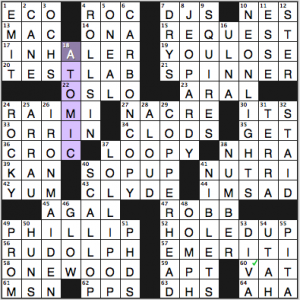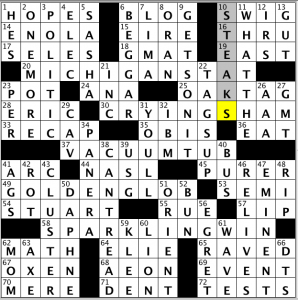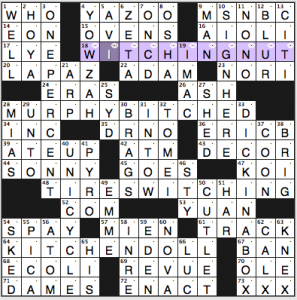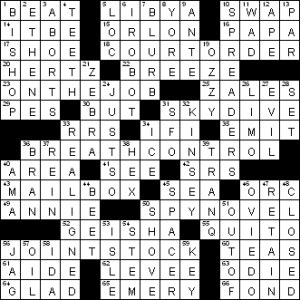NYT 3:25 (Amy)
Tausig untimed (Amy)
LAT 4:46 (Gareth)
CS 6:08 (Dave)
Alex Vratsanos’s New York Times crossword
Do you know your chemistry? Your periodic table of the elements? Four long Down answers begin with a word that’s an element, and the clue number matches up with the atomic number.
- 18d, 38d. [With 38-Down, property of the first part of the answer to each starred clue (appropriately positioned in the grid)], ATOMIC / NUMBER.
- 6d. [*Typist’s duplicate of old], CARBON COPY. Carbon is element #6. You know what was probably much harder back in the day? The “blind carbon copy” that email makes so easy. Was “bcc” a thing in the pre-email era, or was that invented only with email?
- 10d. [*They’re big on Broadway], NEON LIGHTS. I wonder how many theaters still have neon signage. The first three in this alphabetical list don’t, but the August Wilson Theatre has a zippy neon autograph.
- 26d. [*Medieval device with spikes], IRON MAIDEN.
- 29d. [*Anti-Civil War Northerner], COPPERHEAD. Not familiar with this usage; making a mental note of it.
I’m thinking ECO would have worked better with a “green prefix” clue rather than 1a: [“Foucault’s Pendulum” author], what with the OCHS crossing (3d. [Protest singer Phil]) at the O. Both Umberto Eco and Phil Ochs are names I learned from crosswords and rarely encounter elsewhere, which makes them poorly suited as crossing entries.
ROBB gets a modern clue: 47a. [Eldest Stark child on “Game of Thrones”]. Last season didn’t … go so well for Robb.
Likes: JEOPARDY, the fog that ROLLS IN, a game SPINNER, HOLED UP crossing NIBLETS, and LOLLIPOP.
Unfond of: ECO as clued, NES, ON A, ARAL, NACRE, KAN., NUTRI-, “I’M SAD,” DH’S, ESSE, STER.
3.5 stars.
Randolph Ross’s CrosSynergy / Washington Post crossword, “No Finale” – Dave Sullivan’s review
No, the theme entries don’t depict the ending of a Japanese drama, nor do they, in a word-play fashion, add “NO” to the ends of phrases. Instead, the title is to be parsed “No Final-E,” where the letter E has been removed from the ends of phrases.
- [Home to almost 65,000 lakes, e.g.?] clued MICHIGAN STAT – rather timely as the No. 4 Spartans will be playing No. 1 seeded Virginia Cavaliers this Friday night.
- [Crocodile tears?] was CRYING SHAM – are crocodiles known for their ersatz whimpering?
- [Where a cleaner is cleaned?] clued VACUUM TUB – please don’t try this at home, particularly if said vacuum is plugged in at the time.
- [Messy dab of mustard?] was GOLDEN GLOB – are globs necessarily “messy”?
- [Outstanding victory?] clued SPARKLING WIN – it’s now gauche, I believe, to order champagne (or sparkling wine); now, the in-drink is the Italian prosecco.
I’m thinking there are many theme choices here; not sure the constructor has chosen the best examples, but they work for this solver. Seems like more than your usual amount of 3-letter words in this one: HES, PER, AGS, INC, ROT, MOM, AXE, ANA, CAV, USG, IBM, BUN, RUE, BUS, RIP, DTS, LIP, AAA, GMT, EAT, ARC, IRS and GUT by my accounting. None of these are that off-putting by themselves, but they tend to pull attention from the more sparkling longer fill, such as GETS ON IT, TAGS UP, “WHAT THE…” and POLITIC. OAK TAG, clued as [School poster material] brought me back to my childhood; I sure hope kids these days are making posters that way and not just on computers. Finally, I learned that SASHA is a typical nickname for Alexander in Russia, after first thinking Sacha Baron Cohen‘s first name used to be Alexander.
Ben Tausig’s Chicago Reader/Ink Well crossword, “Scratch That”
The theme puts a sneaky ITCH into four familiar phrases:
- 18a. [Huge fan of spells, conjuring, and anything and everything broom-related?], WITCHING NUT.
- 28a. [What happened, perhaps, after “Tower Heist” failed to be nominated for Best Picture?], MURPHY BITCHED. Eddie Murphy was in the movie.
- 48a. [Task in the pit after a blowout?], TIRE SWITCHING.
- 64a. [Blown-up, make-believe sous-chef?], KITCHEN DOLL.
Somewhat amusing, no? The base phrases/words are a lively batch: wingnut, Murphy bed, tire swing, Ken doll.
Highlights:
- 33d. [Classic Samberg-Timberlake “SNL” song], DICK IN A BOX.
- 3d. [Occupy Wall Street target], the ONE PERCENT.
- 4d. [“Holy cow!”], YOWZAH, crossing YAZOO, 4a. [“Only You” new wave duo, as known in the U.K.]. We called them Yaz here in the States, and I love that song (though the synthesizer is starting to sound silly). Love Alison Moyet’s singing voice.
- 40d. [Hobby vehicle for Donald Rumsfeld (seriously)], UNICYCLE. The best trivia clue!
- 10d. [Instruction next to an X], SIGN HERE.
- 7d. [How fewer and fewer albums are released], ON CD. Newspaper crossword clues for ON CD tend to pretend that ON CD is entirely au courant.
Least broadly familiar word: 62d. [Powdery mineral residue], CALX. Etymologically related to calcium via the lime meaning.
Four stars.
Jacob Stulberg’s Los Angeles Times crossword – Gareth’s review
A sparse theme today: 10, 13, 10 with a 5 letter revealer. I’m impressed that Mr. Stulberg came up with 3 phrases both parts of which can be completed by OUTOF! I like 36a, [Voice coach’s concern], BREATHCONTROL a lot as an answer as well. The other pair are 18a, [Mandate from the bench], COURTORDER and 56a, [Shared shares], JOINTSTOCK.
The them was brief, but sweet. However, there’s a lot of blank puzzle left… What does one do then? Mr. Stulberg seems to have gone for the cram lots of high-value letters approach. That’s fine when the answers themselves are interesting and don’t compromise the surrounding fill. I’m not sure HERTZ/ZEBRA justifies ITBE/ETHENE/PES. JUSTSO is my favourite answer the grid, giving a nod to Kipling even if not mentioned in the clue. SKYDIVE is also a great answer, and the crossing OZZY looks neat too… It does indirectly result in the weird partial IFI though. TRANQ is an interesting case, it’s in the dictionary, and widely used in scrabble, but I’ve never seen or heard it in regular life before. Is this common Stateside? Last remark – SPREADERS – I’m so amused by the clue [Farming implements], as it carefully avoids mentioning what these implements spread!
3 Stars. Liked the theme, wish the rest of the puzzle was a little more controlled.
Gareth




Oh, dear. Yes, bcc was a thing in the pre-email era. You (carefully) removed the original, regular cc’s and their respective carbons, then (carefully) re-inserted the bcc’s and their respective carbons to type their names. Didn’t think I was such a geezer…
Document preparation and duplication have sure come a long way. My mother’s 1959 Ph.D. thesis was typed on a manual typewriter, the original on regular paper, and the seven or so copies all on onion skin paper. These were all separated by carbon paper, and wow was it a hassle to fix errors since that had to done for each page individually (the default position was that one learned to type without typos!). Through most of the 60’s, even after introduction of increasingly sophisticated electric typewriters for offices and home, business correspondence was typically handled with originals and true carbon copies, be the recipient publicly revealed (cc) or not (bcc). Once half-way decent photocopying became available, one could improve the content and appearance of documents by literal cutting (with a scissor) and pasting (with glue, scotch tape, etc.)
This next paragraph has a couple of spoilers, so beware. I really enjoyed seeing Alex Vratsanos’ puzzle in print, since a bunch of us had helped beta test it back in May 2012. Alex’s theme entries brought to mind this previously unpublished gem by Charles Deber, entitled “It’s Element-ary.” Finally, the “bcc” concept was central to this November 2012 NYT puzzle, constructed with Victor Barocas.
To close, I remain curious what other reminiscences readers of this blog will share about pre-word processing cc’s and bcc’s. Wikipedia has articles on both, respectively here and here.
George, I’m afraid my reminiscences are pretty much identical to yours — laboriously loading onion skin sheets, interspersed with carbon paper into a manual typewriter and then having to correct every sheet. The only thing I would add is typewriter paper was available (from Eaton and others) that had a sort of oily coating which allowed a mistake to be erased with an ordinary pencil eraser, so these sheets could be corrected more quickly than regular onion skin. But the surface of that paper was as icky as it sounds.
My other recollection is that my graduate department had what they called a Gestetner Machine, on which we made copies of our seminar papers to be distributed to classmates. You typed on a special sheet of paper, which created a raised surface, then you clipped the original to a revolving drum, and hand cranked the drum. The raised surface inked each sheet of paper as it was cranked out, and created reasonably usable copies. The number of copies you could produce was quite limited — perhaps a few dozen.
Gestetner made mimeograph machines, which I used in high school. The classic ink color, of course, was purple, but the teal ink had the same wet smell as the purple. Most grade-school quizzes were run off on the mimeo, before photocopiers became more commonplace and affordable.
As a child growing up in the 70’s there was nothing more pleasurable then getting the slightly damp quiz with that luscious chemical scent wafting off the paper. There was also no better schadenfraude then seeing your evil teacher’s hands and hopefully shirt besmirched with ink.
This discussion set off peals of memory, so forgive me if I point out that although the word Mimeograph has arisen here, that was the big-brother, official sort of duplication process, while others seem to be talking about the Ditto machine, or spirit duplicator, the really fast and somewhat more aromatic process. (I could post links, but Google will get you to either one even faster.)
Shoot, Mr. Kerfuffle, I was absolutely referring to dittos! You’re telling me the mimeograph is a different creature altogether?
We got hold of an ancient Peace Corps surplus ditto machine when we were teaching in Afghanistan. It ran on alcohol. The problem was, where does one find alcohol of any description in rural Afghanistan, where alcohol consumption was a stoning offense? Answer: for the right price, anything is possible.
Typewriters bring back memories of writing term papers on “corrasable” paper (or heavy use of liquid paper, if need be). The big advance in technology back then was my Smith-Corona with a correction tape cartridge. Still have it in the garage someplace.
I started in the work world before email. When we needed to send a letter, we wrote it in longhand and gave it to the word processing department. They’d usually have it ready by the next day. If we needed it sooner, my boss’s secretary was open to bribes (candy usually did the trick). If it was real quick, I’d borrow her typewriter while she was at lunch. This was how we did it in the 1980s. When I got to be a boss a few years later, we didn’t have a word processing department anymore, or secretaries, or even an office. I had a laptop with a dial-up modem connected to my phone line at home. Email. So advanced.
And my niece, still in her 20s, thinks she’s getting old because she made it through college before there was Facebook.
Running for cover – golf clues in the NYT and LAT – even though I golf (about as well as I do crosswords, which translates to a double digit handicap), I foresee some interesting comments before the day is out!!
Other than that, I had no difficulties with either today – and I have actually read Foucault’s Pendulum (to prove something to a girlfriends father who was a university professor and I was young enough to think that would actually help – not so much!). That book worked much better as a paperweight – but I can see why having two esoteric name crossings could be problematic.
ECO/OCHS was actually the easiest fill. Takes all kinds, I suppose. :-)
ECO/OCHS was my first fill too and this corner the easiest. Sad about Ochs. I had trouble parsing IMSAD, couldn’t get past IM (I as a schwa). My problem.
What do you have against “IMSAD”? Thought that was cute, with the emoticon clue.
Feels arbitrary. Are IMHUNGRY, IMFAT, and IMHAPPY as crossword-worthy as something like IMSORRY or IMALLEARS?
IMHAPPY can be clued as the Pharrell lyric if nothing else.
IMFAT may not be NYT-worthy, but of course that’s a sentence you hear from people uncomfortable with their weight.
Spend enough time on Twitter, and random people will tweet “IMSAD” or “IMHUNGRY”, because what else is there to tweet about?
Gripes about Twitter being boring and mindless must come from people who either haven’t been on Twitter since it was brand-new or from people who haven’t cultivated a collection smart and interesting people on Twitter. I don’t spend much time on Twitter, but I have my editor tweeps, my crossword tweeps, feminist tweeps, Chicago Tribune and NPR and New Yorker tweeps. If you think any of these people are using Twitter to talk about their current mood or what they’re having for lunch, you’re sorely mistaken. Nobody is meant to just read random tweets. That would be like hopping around the Web to discover random sites, as we did around 1996.
nice nyt puzzle — embarrassed to say I didn’t even realize the theme answers were positioned to match their elements’ atnos (in puzzle-ese) until coming here!
Theme is exceptionally clever!
I struggled in the ROBB/NIBLETS area, as I didn’t know either. Phil OCHS is definitely worth checking out! He’d probably be a lot more famous, but his songs were… not radio-friendly.
I think Gareth knows more about American protest music than most Americans do. Certainly he knows more than I do!
Even I like Phil Ochs.
My brother-in-law gave me a book on the history of protest music for Christmas, figuring it was my kind of thing (it was). It had a full chapter on Phil Ochs. He was an interesting character who came to a sad end.
An amusing book of interest noting 1930s’ protest songs of Seeger et al:: Ronald Radosh’s “Commies – A Journey Through the Old Left, the New Left, and the Leftover Left” published in 2001. See review at
http://www.nytimes.com/books/01/06/24/reviews/010624.24good.html
Re the Tausig — Yes the theme was clever. But it never ceases to amaze me the way people will rail against one or two entries they consider obscure. It is almost impossible for me to react favorably to a puzzle which includes 4, 22, and 36a; and 5, 12 and 33d. That’s a total of 31 squares which for me might as well be unclued, or clued in Chinese characters. (No, I don’t know any Chinese characters). That’s about 20% of the white squares in the puzzle. Way too much to give up.
And I don’t get 61a {Song, as it were} for “train.” Incidentally, I assume that the clue for 51d “dad” (sic) joke was supposed to be “bad?” But that quadrant was already so impossible, I was ready to believe almost anything.
TRACK, not TRAIN. Surely you have heard mentions of “album tracks”?
Now, think how much more you would enjoy crosswords if you would just open yourself up to the world of Pop Culture Bruce Doesn’t Know Yet.
There’s a whole Twitter feed of dad jokes: Bad Dad Jokes.
I guess I misread the answer key, along with everything else.
Believe it or not I am trying to do just that — (i.e. listen to a wider range of music), and contrary to popular belief there’s quite a bit of rock and pop that I like and consider interesting. I’m not up on the endless subtleties of subgenres e.g. “arena rock” or “artpop” recently referred to by BEQ. I like Axl Rose and Jon Bon Jovi (actually Bongiovi), and many others, and I consider Roger Watters to be in the tradition of good English composers and I could point out similarities and convergences with British classical music.
I do not have an implacable, general aversion to rap. Certainly I respond to the verbal fluency and demonic energy. I loved the Eminem movie, and I recently heard one of the well-known rappers — I forget who — on a documentary, obviously improvising to illustrate, and he went on and on for minutes — really quite impressive and amazing.
Well, Jon Bon Jovi is arena rock, so there you go.
Phil Ochs was a major talent in the Pete Seeger tradition that spawned Bob Dylan and so many other lesser known but talented writer/singers like Tom Paxton, Eric Andersen, Dave Van Ronk, and Mississippi John Hurt and of course Joan Baez and Joni Mitchell. Sadly Phil took his own life at 36.
Beg to differ on one point (for now). Mississippi John Hurt was rediscovered by folkies in the 1960s, but he initially recorded and established himself back between the wars.
Agreed. Mississippi John Hurt was an old man with a long career by the time he played with Pete Seeger. Like many other 20s/30s folk singers he was “rediscovered” in the 60s. Dock Boggs, Skip James, and other great artists had the same trajectory.
Thank you all for solving my puzzle, and for your many interesting comments. Despite the constraints of the construction, I am very happy with how it turned out… go to http://www.xwordinfo.com/Crossword?date=3/26/2014 for some backstory on it.
Re: CS and crocodile tears – maybe it was a joke / rhetorical question but the clue refers to insincerity likely deriving from when crocs cry (not in the emotional sense though…more like drip water from their eyes) upon eating prey – I thought it was from Aesop but it seems like that mayve been wrong…